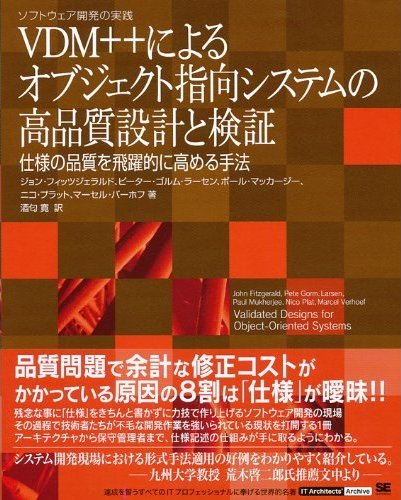Overture Tool
Formal Modelling in VDM

 |
 |
Validated Designs for Object-oriented Systems
About the book
Object-oriented design methods are commonplace in computing systems development, but are often dismissed as little more than ‘boxes and arrows’. If systems developers are to gain the full advantage from such methods, they should be able to achieve designs that are not merely the subject of heated argument, but can be improved by careful, rigorous and machine-supported analysis. Validated Designs for Object-oriented Systems describes an object-oriented design approach that combines the benefits of abstract modelling with the analytic power of formal methods, to give designs that can be rigorously validated and assured with automated support. UML class models are augmented with consistent, complementary functional views in VDM++, with the engineer free to move between them. This allows developers to choose levels of abstraction and rigour appropriate to each given project. Aimed at software architects, designers and developers as well as computer scientists, no prior knowledge of formal methods is assumed. The elements of functional modelling are introduced using numerous examples and exercises, industrial case studies and experience reports. This book complements “Modelling Systems” by John Fitzgerald and Peter Gorm Larsen, now available in its second edition.
Tool support
SCSK Systems has kindly provided a special version of VDMTools to support our book. VDMTools Lite is available free of charge and can be downloaded from www.vdmtools.jp/en. Versions are available for Windows 2000/XP, Mac (G4, G5 and x86) and Linux. For academic users, site licenses are available, also free of charge, for the full version of the tool. The full version includes automatic code generation for Java and C++, dynamic link library and CORBA support. Please contact VDM.SP@csk.com for any queries related to licensing. The alternative to VDMTools is to use the Overture open source solution built on top of the Eclipse platform. A tutorial introducing Overture in a way similar to chapter 3 of the book can be downloaded from here. Overture stand-alone executables for Windows, Mac and Linux are also freely available.
Reference
Validated Designs for Object-oriented Systems. John Fitzgerald, Peter Gorm Larsen, Paul Mukherjee, Nico Plat and Marcel Verhoef. ISBN: 1-85233-881-4. Springer, New York. 2005.
Download the BIB file entry from the publication list
You can purchase the book on-line at the Springer web-site. A Japanese translation is available as ISBN 978-1-85233-881-7 from August 2010, also available from the same publisher.
Course material
Slides supporting the book can be found on at teaching materials
Book Examples
Most chapters of the book have major examples used to illustrate the different concepts presented in the chapter. Here it is possible to extract the sources for each of the chapters.
- The chemical plant example
- The initial chemical plant example for VDMTools analysis
- The robot controller example
- The Congestion warning system with sequences
- The Congestion warning system with mappings
- The enigma example
- The control speed limitation and monitoring example
- The POP3 example
Exercises
The robot controller was made using sets in chapter 6. For various reasons part of this model was not natural. The solution here demonstrates how it can be made more naturally with the presence of sequences.
Errata
page 75
The last sentence on the page should be changed from:
Thus, the month can be extracted from a date by selecting field 2:
to:
Thus, the street can be extracted from an address by selecting field 2:
page 90
There is a problem with the definition of the Sample function definition. It makes use of the Sex function. However, Sex takes a CPRNoDigits4 as a parameter whereas in Sample it is being passed a CPRNo` in the line:
p in set pop and Sex(p) = sexreqd
One solution is to make use of the GetCode() operation that is defined on p93.
The line then becomes:
p in set pop and Sex(p.GetCode()) = sexreqd
This change applies to both boxed definitions of Sample.
page 93
The second sentence following the first VDM++ box should have:
(introduced later)
changed to:
(introduced previously)
page 155
The body of CarPassingEvent should say:
NewPassage(distanceBetweenLoops / drivingTime)
instead of:
NewPassage(distanceBetweenLoops * drivingTime)
page 162
The definition of ResetLog and WriteLog should be changed to:
class OperatorControl
...
public ResetLog:() ==> ()
ResetLog() ==
atomic
( messageLog := [];
locations := [] );
public WriteLog: seq1 of char * CWS`Location ==> ()
WriteLog(message, location) ==
atomic
( messageLog := messageLog ^ [message ^ ConvertNum2String(location)];
locations := locations ^ [location] );
end OperatorControl
This change is necessary in order to ensure that the invariant (requiring the length of the instance variables messageLog and locations to be equal) is checked after both instance variables are updated.
page 180
The first box should be changed to:
class CongestionSensor
...
instance variables
passageSensors: map CWS`Lane to PassageSensor := {|->};
end CongestionSensor
page 218 – 232
The names of some of the operations in the VDMUnit framework/standard library have changed since the book was published.
page 292
Figure 12.3 should be changed to the following figure:
page 355/356
Exercise 5.1 All three boxed solutions should be modified as described for p90 above.
page 357
In the solution to Exercise 6.7 should the answer for the first exercise only one quote with apple.
page 362
In the solution to Exercise 7.8 should the answer for the second exercise be changed from [9,3,2,3] to [true,false,false].
page 364
In the solution to Exercise 7.12 should the answer for the first exercise be changed from [true,false,4] to [true,true,4].
page 365
In the solution to Exercise 7.16 should the answer to the last exercise be changed from {[5]} to {[5,4,5]}. In the solution to Exercise 8.2 should the answer to the last exercise be changed from {1 |-> 0.5} be changed to {|->}.
page 366
In the solution to Exercise 8.6 should the answer to the last exercise be changed from {1 |-> 5, 3 |-> 1, 5 |-> 1} be changed to {1 |-> 6, 3 |-> 1, 5 |-> 1}.